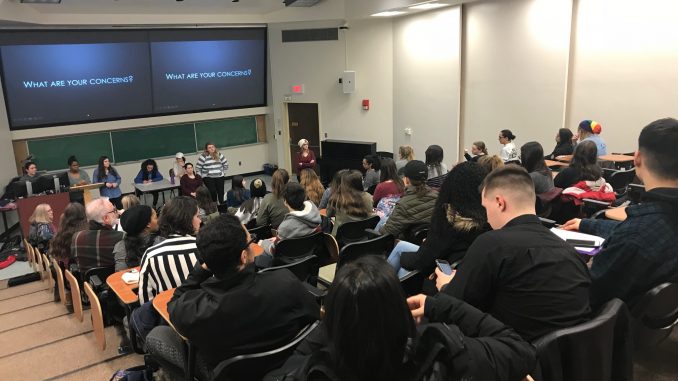
Hanna Da’Mes, Staff Writer |
On February 23, Childhood Education students gathered in IRC to host an open discussion titled “A Voice for Change.” This event covered the school shooting in Parkland, FL. Originally it was going to be held for just Education majors, but upon further reflection, students realized that it was a conversation that should involve everyone.
The event opened with “Evan,” a video by advertising agency BBDO New York, that promoted the “Know the Signs” campaign that was ignited by the shooting at Sandy Hook. The video intends to raise awareness on the signs people might exhibit preceding an act of gun violence. As most of the students were Education majors, many spoke of the responsibility of teachers to know the signs of a student who may be prone to using gun violence, and to contact and communicate with parents if an issue threatens to arise.
The group moderating the discussion then asked the room what the concerns are on campus. Students responded with interest in the locks on academic building doors, the big glass windows, and the problem of hiding in campus classrooms. Phil Bidwell, IT Specialist from the Office of Facilities, mentioned how his department is looking into making class room doors lock from the inside. In the case of an active shooter in an academic building, the professor would be able to lock the door from the inside, thus keeping the shooter out and the students safe.
Lieutenant Callahan, from the University Police Department at Oneonta (UPD), urged students to always “be alert, be aware of [their] surroundings.” He advised the practice of staying off cellular devices while walking on campus, and everywhere else for that matter, because it can be very distracting from possible threats in everyday life. A student asked both Callahan and Bidwell about the campus alert system’s functionality. Bidwell responded, “Short answer, yes. Long answer, there is a delay.”
By the time UPD finds out about the shooting and is able to send out the message, most of the damage would already be done. He emphasized the short time frame in which shootings occur. A shocked silence followed his claim that a typical school shooting lasts about five to six minutes.
One student suggested a program similar to “The One,” the online course that students are required to complete before their first semester at SUNY Oneonta, except the course would entail information about the procedures in the event of a school shooting.
Another student countered this by saying that if all students knew of the procedures, the potential student shooter would also be aware of them. But others argued that the importance of informing the masses about the procedures outweighs that chance.
Dr. McKay, Associate Professor in Childhood Education, shifted the conversation to mental health. There was a discussion on the stigma of mental illness, and how the restricted conversation on the subject makes getting help less accessible.
Noticing that the entire back row of the lecture hall had remained quiet throughout the discussion, Dr. McKay asked if any of them had anything to say. Some students took this chance to speak up about their stance on gun control.
One student’s opinion was that teachers in public schools should be armed if that would help them feel safer in their classrooms. These teachers would go through extensive training before being armed with protective guns. Others argued from the perspective of current and future educators about feeling safe in school and having no desire to carry a gun in a classroom. The back row responded that the statements expressed had been very biased.
Although the room had developed a tense atmosphere as the discussion went on, the student who spoke first in the back row united the room by saying, “Regardless of political stance, we need to work on impoving our society and being better people.”
Leave a Reply